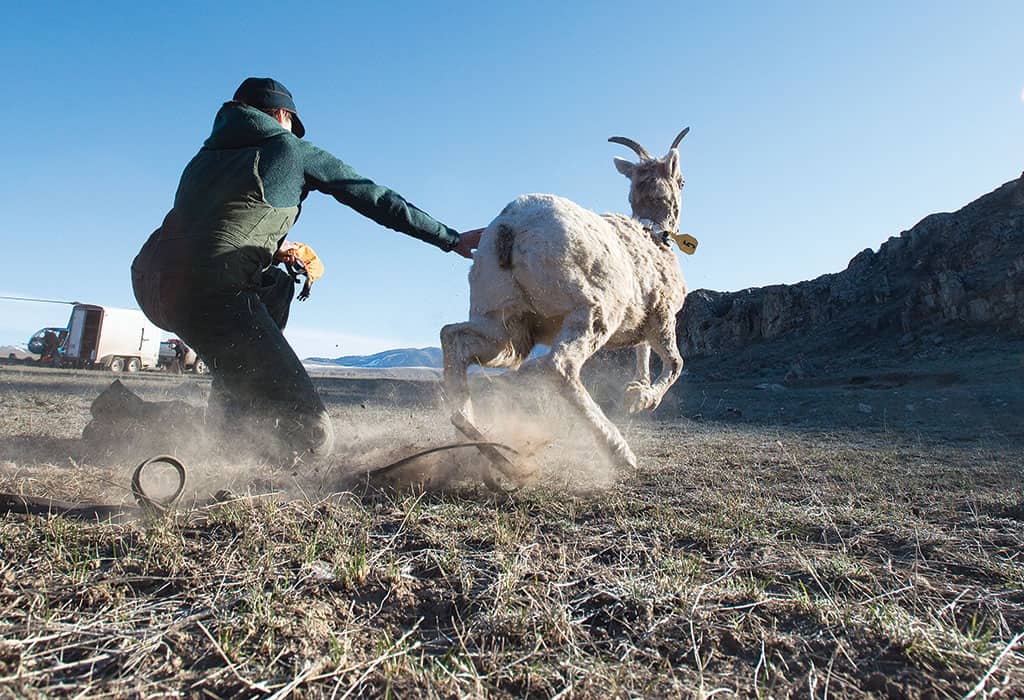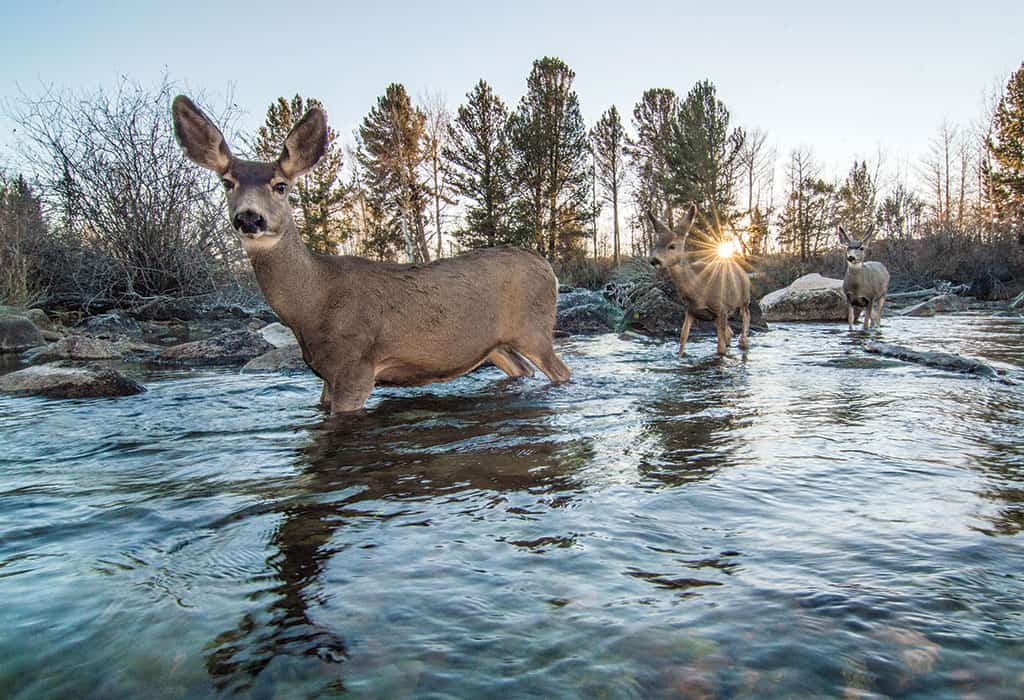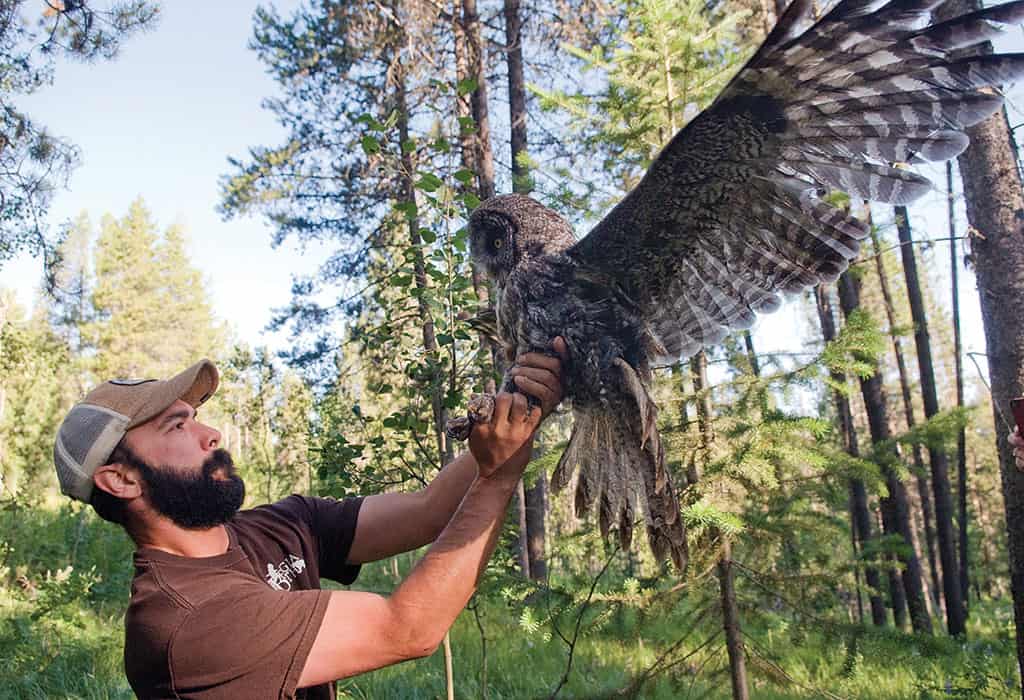Read The
Current Issue
Where the Wild Things Are
Jackson Hole is one of the world’s great places to study wildlife. Area scientists follow animals by land, air, and satellite.
By Julie Fustanio Kling

THE MONOTONOUS BEEPING signaled a mortality. Using a new technique, graduate students in wildlife biology were tracking bighorn sheep in the mountains. As they triangulated in on the site of the sheep, the students realized there had been an avalanche. They could see it. They also saw the sheep’s GPS collar, in clear view on top of the snow, but there was no sheep. Behind the collar was a path along which a predator—a wolverine, judging by the tracks—had dragged the animal. The students could also see where the wolverine had dug the sheep’s body out of the debris pile. But there wasn’t a morsel of the sheep left.
The students weren’t just tracking Grand Teton National Park’s (GTNP) sheep population, but also a more populous area species: backcountry skiers. Their study looked at whether sheep avoided areas used by skiers. They didn’t collar skiers, though. Students handed out trackers to those departing the Bradley/Taggart lakes trailhead, the most popular trailhead in the park, and asked them to ski with the trackers in their packs all day. They were to return them at one of several designated areas at the end of the day. The researchers later downloaded the skiers’ tracks and compared them to tracking information provided by the GPS collars on the sheep.
Alyson Courtemanch, a wildlife biologist for the Wyoming Game & Fish Department and one of the scientists involved with the sheep/skier study, describes wildlife tracking as a treasure hunt, and the above as one of the times when she found gold. She and the graduate students found that the dead sheep had indeed been avoiding an area above where skiers traveled. Also they found evidence—the tracks around the collar—that a wolverine, an animal that is exceptionally hard to track, was in the area. Retrieving GPS collars can be exhilarating, Courtemanch says. But collars are just one of the ways humans can “watch” from afar. What are we finding?
“WE’VE BEEN COLLARING animals now for two decades. But almost every time we put a collar on, we learn something new,” says Courtemanch, adding that the study mentioned above showed sheep were creating new pathways as a result of skiers. The maps in her office, burgeoning with dots color-coded for each ungulate, resemble pointillist paintings. They grow by the day as technology improves.
Collars using GPS linked to satellites are more revealing than the radio transmitters that twins Frank and John Craighead pioneered when they became the first to collar a grizzly bear in Yellowstone in the 1960s. These radio-tracking collars required antennas to follow them. GPS collars don’t require bulky antennas, but they are exponentially more expensive and come with monthly satellite service fees. Bryan Bedrosian, senior avian ecologist at the Teton Raptor Center in Wilson, is trying to change that with a $250,000 grant he received from the National Science Foundation. With the grant he’s making GPS collars with a 3-D printer. These printed collars are a fraction of the cost of traditional ones. Scientists use his collars to track golden eagles from Alberta, Canada, to Montana, in addition to moose in the Wyoming Range.

“What we are learning from all this GPS collaring is we know what good winter and summer habitat is,” says University of Wyoming professor Matt Kauffman, who has been involved in several moose and mule deer studies that required tracking animals. “We are trying to appreciate more fully how important it is for animals to move between habitats, and how we can keep these habitats connected.”
Last year Kauffman partnered with Hall Sawyer to found the Wyoming Migration Initiative, a nonprofit creating an atlas of ungulate migration patterns in the state. While working on the atlas, Sawyer stumbled onto a new record—the longest mule deer migration ever documented. The superlative doe, eventually named Jet, was tracked 150 miles from her low-elevation winter range in the Red Desert east of Rock Springs to the peaks in the Gros Ventre Range near Hoback Junction. (You can follow Jet’s movements on the Wyoming Migration Initiative’s Face-book page.) Jet moved in and out of U.S. Forest Service (USFS), Bureau of Land Management, and private lands forty times, highlighting the need for better communication between land-management agencies. “All of these agencies have different mandates, and none of them have a consistent plan with how to deal with wildlife,” Kauffman says.
Another reason animals are traveling farther may point to climate change. Kauffman says mule deer searching for early spring vegetation are logging more miles up and down in a pattern known as “surfing the green wave.” “They are riding the front edge of the green wave in spring as it marches up the mountain,” he says. “Drought and climate change make it more difficult for them to surf the wave.”
TETON COUGAR PROJECT, a local group funded by the nonprofit Panthera, has learned much about the social behaviors of mountain lions over the fifteen years it has tracked the species in the valley. Through camera traps the team has captured cougars—long thought to be solitary animals—playing and sharing meals. Through tracking the group has also seen the cougar population dwindle in the area between Curtis Canyon, Teton Pass, Jackson Lake, and the lower Gros Ventre Range. The researchers formerly focused on lion population and behavior. Recently the USFS asked them to count kills rather than cats. Technology has improved so much that researchers tracked 400 elk and deer kills this year, versus a total of 587 in the eleven years prior, says the project’s leader, Mark Elbroch.
When the red dots on Elbroch’s computer show a lion lingering in an area, he mobilizes his research team immediately. Once the chase is on, “It can take twenty minutes to two hours to catch a cat,” he says. Once up close, they can observe behavior to see if the lion is expecting a new litter and replace the collar if necessary. Most of the collars are set to release—fall off—after a set period of time. Back in its early days, Teton Cougar Project researchers would get to a kill site and, because there were so many cougars at the time, find they had four different trails to follow. These days, they are lucky to get one.
“We’ve invited folks out to track with us, but we’ve lost a lot of media along the way,” Elbroch jokes. The weather is often harsh, and the animals prefer areas without trails. “Catching a cat takes a ridiculously stubborn person,” he says.

JASON WILMOT HAS been looking for lynx since 1999. He has found only two dens. After a six-year break from tracking them, Wilmot wonders if there are any left in Wyoming. He’s back on the case now, though, using one of the most basic tracking skills, following an animal’s “fuzzed-out” footprints, alongside a more techy method of tracking. Wilmot installed fifty-five camera traps in areas lynx have been known to travel between Pinedale and Grand Teton National Park.
“Lynx are a pain in the butt,” he says, adding that wolverines and fishers are also on his list of difficult animals to track because they share the same habitat. “Wolverines are the same [as lynx], if not worse, because you can’t keep a collar on them. Their neck is the same size as their head.”
Snowshoe hares, a favorite meal of lynx, are the key, Wilmot says. He adds that the preferred habitat of the lynx is wilderness that is recovering from forest fires. In his tracking toolkit, Wilmot carries stinky bait, which he places on traps jerry-rigged from gun brushes and tinfoil and set on regenerating aspen trees. The idea is that when a lynx eats the stinky bait, the trap collects hair samples from the animal. If and when he finds evidence of a lynx, Wilmot says there may be implications for oil and gas leases in the area where the animal is found. Lynx are on the endangered species list.
THE PROLIFERATION OF elk that migrate to the National Elk Refuge every winter makes Jackson an easy place to study elk habits, and also to control the animals’ population. The goal of the agencies whose combined efforts feed, trap, and regulate hunting of the herd is to have no more than 11,000 elk in the refuge. Because of the ongoing threat of brucellosis, an infectious disease caused by bacteria, as well as other contagious illnesses, the refuge is making a concerted effort to irrigate more of its 25,000 acres. The hope is that this additional irrigation will grow more grass for the elk to forage on, and also encourage the herd to spread out. The latter helps to reduce the risk of illnesses quickly spreading through the herd.
Last winter Wyoming Game & Fish, the National Elk Refuge, and GTNP biologists sought to discover why the number of elk migrating to Yellowstone was dwindling. Was it predators? Drought? Were 1988’s wildfires still impacting the food supply? Their hunch is the latter. They partnered with the University of Wyoming and are currently at work to see if they can prove it.
THE REINTRODUCTION OF wolves into the Yellowstone ecosystem was, and remains, controversial. Reintro-duction was an unqualified success, and wolves were removed from the endangered species list in Wyoming between 2012 and 2014. But they were recently relisted in the state and the management of their population placed under the jurisdiction of the U.S. Fish and Wildlife Service (USFWS). USFWS wildlife biologist Mike Jimenez takes aircraft flights every two months to keep a count of the packs, which are easiest to see in the winter because their dark coats contrast with snow. “Wolves are hardwired to expand out of areas in which they were born,” Jimenez says. “Wyoming is no exception.” As of last winter there were eight to ten wolf packs in the Greater Yellowstone area and thirty packs around the state of Wyoming.
Observation flights can be one of the most dangerous but effective tools of the trade, says U.S. Geological Survey biologist Dan Thompson. Mountain weather can lead to unexpected turbulence, yet Thompson still takes to the air. He used to track wolves but now focuses on grizzly bears, another animal on the endangered species list (but possibly soon to be removed). One of the newest tracking tools Thompson uses captures thermal imagery and allows him to identify species from above. “It picks up the heat image of mammals,” he says. “They’ve used it for sage grouse, even. You can zoom in and tell if a black spot is a grizzly bear or a black bear, depending on the color.”
Thompson says gadgets and gizmos will never replace “the kind of tracking that gives you the best information—walking in an animal’s path. The best trackers can tell you what’s going on with a set of prints in the mud. Technology has changed that. But in the end we are just out there trying to figure out what’s going on in the landscape. We are trying to answer questions to maintain wildlife on the landscape along with people.”




